Swiss Federal Railways
 Head office inBern | |
Native name | Schweizerische Bundesbahnen SBB(German)[1] Chemins de fer fédéraux suisses CFF(French)[1] Ferrovie federali svizzere FFS(Italian)[1] Viafiers federalas svizras VFF(Romansh)[2][3][4][note 1] |
|---|---|
| Company type | state-ownedAG/SAregulated by public law |
| Industry | Rail Transport |
| Founded | 1 January 1902 |
| Headquarters | , Switzerland |
Key people | Vincent Ducrot,CEO Monika Ribar,chairpersonof theboard of directors[5] |
| Revenue | |
| Total assets | |
| Total equity | |
Number of employees | |
| Divisions | Passenger, SBB Cargo, Infrastructure, Real Estate |
| Website | sbb |
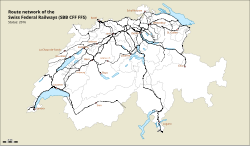 SBB network (for the whole Swiss railway network see:Rail transport in Switzerland) | |
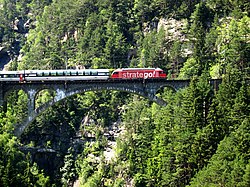 InterCityon the oldGotthard Line | |
| Overview | |
|---|---|
| Dates of operation | 1 January 1902–present |
| Technical | |
| Track gauge | 1,435 mm(4 ft8+1⁄2in)standard gauge |
| Electrification | 99% 15, 1% 25kV,16.7, 50HzOverhead line |
| Length | 3,230 km (2,007.0 mi) |
Swiss Federal Railways(‹See Tfd›German:Schweizerische Bundesbahnen,SBB;French:Chemins de fer fédéraux suisses,CFF;Italian:Ferrovie federali svizzere,FFS)[1]is the national railway company ofSwitzerland.
The company, founded in 1902, is headquartered inBern.[8]It used to be agovernment institution,but since 1999 it has been a special stock corporation whose shares are held by the Swiss Confederation and theSwiss cantons.It is currently the largest rail and transport company of Switzerland; it operates on most standard gauge lines of theSwiss network.It also heavily collaborates with most other transport companies of the country, such as theBLS,one of its main competitors, to provide fully integrated timetables withcyclic schedules.
SBB was ranked first among national European rail systems in the 2017 European Railway Performance Index for its intensity of use, quality of service, and safety rating.[9]While many rail operators in continental Europe have emphasised the building ofhigh-speed rail,SBB has invested in the reliability and quality of service of its conventional rail network, on both national and regional scales. In addition to passenger rail, SBB operates cargo and freight rail service, through its subsidiarySBB Cargo,and has large real estate holdings in Switzerland.
Name
[edit]The company is commonly referred to by the initials of its three official names (in German, French, Italian) – defined by federal law SR/RS 742.31 (SBBG/LCFF/LFFS) Art. 2 §1[1]– either asSBB CFF FFS,or used separately. The official English abbreviation is SBB.[note 2][3][2][4][10]
While the officialRomanshname,Viafiers federalas svizras(VFF), can be found in federal laws and associated documents,[3][4][2][11]as well as Romansh-language media,[12]it is not used by the company itself.
Organisation
[edit]Swiss Federal Railways is divided into three divisions and eight groups.[13]The divisions manage the relevant operational businesses. These divisions are:
- Passenger traffic
- Infrastructure
- Real estate
The former divisionCargobecame an independent group company at the beginning of 2019.
SBB's eight groups manage the company and support the operational business of the divisions with service and support functions. These groups are:
- Finance
- HR
- IT
- Communications
- Corporate Development
- Safety & Quality
- Legal and Compliance
- Supply Chain Management
The corporation is led in an entrepreneurial manner. A performance agreement between Swiss Federal Railways and the Swiss Confederation defines the requirements and is updated every four years. At the same time the compensation rates per train and track-kilometre are defined.
A subsidiary,SBB GmbH,is responsible for passenger traffic in Germany. It operates theWiesentalbahnand theSeehasservices. Other subsidiaries areTHURBO,RegionAlps,AlpTransit Gotthard AG,Cisalpino,and TiLo (the latter in conjunction with Italian authorities). Swiss Federal Railways hold significant shares of theZentralbahnandLyria SAS.
TheStiftung Historisches Erbe der SBB( "SBB Historic") was founded in 2002. This foundation takes care of historic rolling stock and runs a technical library in Bern, document and photographic archives, and the SBB poster collection.
Figures
[edit]
All figures from 2021:
- Length of railway network: 3,156 km in standard gauge and 103 km metre gauge[14]
- Percentage electrified routes: 100%[14]
- Employees: 33,943[15]
- Passengers carried per day: 0.88 million[16]
- Passenger-kilometre per inhabitant and year: 2,215 kilometres (1,376 mi)[16]
- Stations open to passengers: 795[14]
- Customer punctuality: 91.9% of all passengers reached their destination - measured from departure station including any necessary changes - with less than three minutes of delay (either two or one minute delay, or on time)[17]
- Customer-weighted connection punctuality: 98.9%[17]
- Freight per year: 48 million tons[16]
- Stations with freight traffic: 193
- Railway tunnels: 311[14]
- Railway tunnels total length: 431.0 kilometres (267.8 mi)[14]
- Longest tunnel: 57.1 kilometres (35.5 mi) (Gotthard Base Tunnel)world record
- Railway bridges: 4,925[14]
- Railway bridges total length: 108.7 kilometres (67.5 mi)[14]
- Electric multiple units (fixed compositions of power cars and coaches): 656[18]
- Power cars: 108[18]
- Mainline locomotives: 543 (passenger services: 322 / freight services: 221)[18]
- Shunting locomotives: 224 (38/75/ infrastructure: 111)[18]
- Shunting tractors: 245 (18/24/203)[18]
- Passenger coaches: 1,982[18]
- Freight wagons: 4,671[18]
- Hydroelectric plants: 8[14]
- Electricity produced and procured: 3063 GWh[14]
- Electricity used for railway operations: 2,275 GWh[14]
- Proportion of traction current from renewable sources: 90.2%[14]
The Swiss Federal Railways rail network is totally electrified. The metre gaugeBrünigbahnwas SBB's only non-standard gauge line, until it was out-sourced and merged with theLuzern-Stans-Engelberg-Bahnto form theZentralbahn,in which SBB holds shares.
History
[edit]
In the 19th century, all Swiss railways were owned by private ventures. The economic and political interests of these companies led to lines being built in parallel and some companies went bankrupt in the resulting competition. On 20 February 1898 the Swiss people agreed in areferendumto the creation of astate-ownedrailway company.
Later that year, theFederal Assemblyapproved the purchase ofSchweizerische Centralbahn(SCB) to operate trains on behalf of the federal government. The first train running on the account of the Swiss Confederation ran during the night of New Year's Eve 1900/New Year's Day 1901 fromZürichviaBerntoGeneva,and received a ceremonial welcome upon arriving in Bern. SBB's management board was first formed in mid-1901, and addedSchweizerische Nordostbahn(NOB) to the system on 1 January 1902. This date is now observed as the "official" birthday of SBB.[19]
The following railway companies were nationalised:[how?]
- Aargauische Südbahn(ASB)
- Bötzbergbahn(BöB)
- Schweizerische Nordostbahn(NOB)
- Schweizerische Centralbahn(SCB)
- Toggenburgerbahn(TB)
- Vereinigte Schweizerbahnen(VSB)
- Tösstalbahnincluding theWald-Rüti Railway(WR)
- Wohlen-Bremgarten Railway(WB)
- Jura-Simplon-Bahn(JS) including theBrünigbahn(the latter in 1903)
Other companies were included later, and the rail network was extended.[citation needed]It is still growing today.
On 1 January 1999 the Swiss Federal Railway has been excluded from the Federal Administration and became a fully state-owned (the federal state owns 100% of all shares) limited company regulated by public law (‹See Tfd›German:Spezialgesetzliche Aktiengesellschaft).[citation needed]
First class compartments were discontinued on 3 June 1956, and second and third class accommodation was reclassified as first and second class, respectively.[citation needed]
In 1982 SBB introduced theTaktfahrplan(clock-face schedule), with trains for certain destinations leaving every 60 minutes, greatly simplifying the timetable.[citation needed]
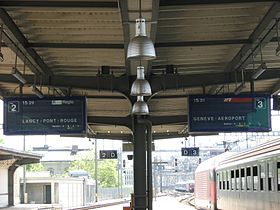
On 12 December 2004 the first phase of Bahn2000, an ambitious programme to improve the company's services, was put into effect.[20]The core element was theZürich-Bern-Baseltriangle, where travel times between the cities was reduced to under one hour, resulting in good connections from these stations for most trains. Some connections between cities got two trains in each direction per hour or more, and the S-Bahn services were intensified to four or more trains per hour. Because of these changes 90% of the timetable was changed, 12% more trains were scheduled and travel times generally improved. It was the greatest timetable change since the introduction of theTaktfahrplan.
For this change to be possible, large parts of the infrastructure had to be modified and many stations were rebuilt, for instance the line fromZiegelbrücketoSargansorBern main stationwhich got the "wave of Bern", a platform over the tracks to provide better access to the platforms and the city centre.
On 22 June 2005 a short circuit on a long-distance power transmission line in central Switzerland led to a chain reaction. The entire Swiss railway network was out of service during rush hour and an estimated 200,000 people and 1,500 trains were stuck at stations or somewhere on the track. It turned out that the SBB power transmission network was overloaded and did not provide enough redundancy to tolerate the shutdown of the four cableAmsteg-Steinenpower line due to construction work. So, the power grid was split in two parts, the northern half being overloaded and the southern half having a load reduction for the SBB power plants are situated in the southern part (theAlps), while most of the power is needed in the northern part (theSwiss plateau). The situation led to high voltage fluctuations and finally breakdown and emergency shutdown of the entire power supply.
In the same year, the Swiss Federal Railways received theWakker Prize,an award given out by the SwissHeimatschutz(an institution aiming to preserve significant buildings), which is usually only granted to communes, for their extraordinary efforts. The Swiss Federal Railways have many listed buildings from well-known architects such asHerzog & de Meuron,Santiago Calatrava,andMax Vogt.
In May 2010, SBB's first integrated network control centre opened inLausanne,to supervise all of SBB's network in the French-speaking part of Switzerland. Another integrated control centre will be opened in Zürich.[21]
All trains and most buildings have been made non-smoking since the timetable change of 11 December 2005.
By the end of 2006, the corporation was handed over from the long-term CEOBenedikt Weibelto his successorAndreas Meyer.
On 13 January 2019, Bloomberg reported that SBB was in talks with German aviation companyLilium GmbHto create air taxis to carry customers from train stations to their final destination.[22]
Clock
[edit]
The Swiss Federal Railways clock designed byHans Hilfikerhas become a national icon.[23]It is special in that it stops for just over a second at the end of each minute, to wait for a signal from the master clock which sets it going again — thus keeping all station clocks synchronised.[24][25]
The clock owes its technology to the particular requirements of operating a railway. First,railway timetablesdo not list seconds; trains in Switzerland always leave the station on the full minute. Secondly, all the clocks at a railway station have to run synchronously in order to show reliable time for both passengers and railway personnel anywhere on or around the station.[24]
The station clocks in Switzerland are synchronized by receiving an electrical impulse from a centralmaster clockat each full minute, advancing the minute hand by one minute. The second hand is driven by an electrical motor independent of the master clock. It requires only about 58.5 seconds to circle the face, then the hand pauses briefly at the top of the clock. It starts a new rotation as soon as it receives the next minute impulse from the master clock.[24]This movement is emulated in some of the licensed timepieces made byMondaine.
Rolling stock
[edit]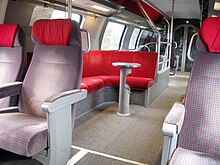
Mainline locomotives
[edit]Steam enginesof the early days of the Swiss Federal Railways were, among others, theEd 2x2/2,E 3/3,A 3/5,B 3/4andC 5/6.
The first electric trial runs using single-phasealternating currentwere made in 1903 on the lineSeebach–Wettingentogether with theMaschinenfabrik Oerlikon(MFO), using the futureCe 4/4locomotives ( "Eva" and "Marianne" ). The electrification of the network started 1919, motivated by the coal shortages during theFirst World War,and new electric locomotives were introduced:Ce 6/8II/Ce 6/8III"Crocodile" (1920–1926),Be 4/6(1920),Be 4/7(1921),Ae 3/6I(1921),Ae 3/6II(1924),Ae 3/6III(1925),Ae 4/7(1927) andAe 4/6(1941). A shift of paradigms happened in 1946, when the age of modern bogie-based locomotives without trailing axles started with theRe 4/4I(1946), followed by theAe 6/6(1952),Re 4/4II/Re 4/4III(1964–1971),Re 6/6(1972),Re 450(1989) andRe 460/Re 465"Lok 2000" (1992–1994).
The delivery of the last Re 465 marked the end of the Swiss locomotive industries with the closure of theSwiss Locomotive and Machine Works.The Swiss Federal Railways were split into three divisions: Passenger, Freight and Infrastructure, each with independent locomotive supply policies. Because the Passenger division got all modern Re 460s and opted for multiple unit trains, mainline locomotives were bought only by the Cargo division, namelyRe 482"Traxx F140 AC" (2002),Re 484"Traxx F140 MS" (2004) andRe 474"ES64 F4" (2004).
Multiple units
[edit]
The first multiple units originated from theSeetalbahn,which was formed in 1922. Larger series were uncommon until after 1950:Be 4/6(1923),De 4/4(1927),BDe 4/4(1952),RBe 4/4(1959),RBDe 560"NPZ" (1984) andRABe 520"GTW"(2002).
The first multiple unit trainsets were bought for the introduction of theTaktfahrplanon the line Zürich–Meilen–Rapperswil in 1967:RABDe 12/12"Mirage" (1965) andRABDe 8/16"Chiquita" (1976). Multiple unit trainsets started to prevail in the 1990s, especially for commuter traffic:RABDe 500"ICN" (1999),RABe 523 (et al.)"FLIRT"(2004),RABe 514"DTZ" (2006), andRABe 503(2008). While locomotive-hauled trains are rarely seen in commuter traffic nowadays, they are still the usual in intercity traffic. In 2011, Stadler'sRABe 511were introduced in Zürich's S-Bahn and in 2012 was introduced as a Regional Express betweenGenevaandRomontand Geneva andVeveyandBernandBiel.
Some of the most popular historic multiple unit trainsets are theRoten Pfeile( "Red Arrows" ) (RAe 2/4) and the "Churchill-Pfeil"(RAe 4/8). In international traffic theTrans-Europ-Express(TEE) diesel trainsets appeared in 1957, but were replaced by four-systems electric trainsetsRAe TEEIIin 1961.
On 12 May 2010, the Swiss Federal Railways announced its largest order of rolling stock; buying 59 double-deck EMUs (Twindexx) from Bombardier, plus an option for another 100 trainsets. The new trains were originally intended to be delivered starting in 2012, but due to several delays, deliveries began in 2017 and end by 2020.[26][27]
In addition, SBB has received and, as of 2016, is still in the process of delivering,New Pendolinos[28][29]and has ordered 29SMILEs,with an option for 92 more, expected to enter service in 2019.[30]
Languages
[edit]
SBB uses three official languages: German, French, and Italian. TheRomansh-speaking regions in the canton ofGrisonsof Switzerland is served mostly by theRhaetian Railway.Trains are branded "SBB CFF FFS".
Stations are named and signposted exclusively in the language of the locality. Stations of bilingual cities are named and signposted in both local languages (e.g. Biel/Bienne and Fribourg/Freiburg). The timetable only uses such official names regardless of the languages of the timetable.
Announcements in stations are usually made in local languages. However, in stations frequently used by foreigners (airports or tourism regions), in-station announcements are also made in English. On-board welcome announcements are made in all official languages of the regions served by that train, with the additional English ones onboard IC trains. Then the stops are announced in the pre-recorded local language of the town. For stations of bilingual cities, the language of announcement changes at the time of stop: when trains travelling from the French-speaking region to the German-speaking region via the bilingual city ofBiel/Bienne,announcements are made in French until arriving at Bienne, and then switch to German after departing from Biel. Upon arriving at big hubs, the train conductor takes the microphone to announce in all official languages of the regions served by that train (plus English onboard IC trains) that the train is arriving, if the train is on time or not, and next connections at the station.
For instance, the main station in the German-speaking Zürich is signposted asZürich HB(short for Zürich Hauptbahnhof) exclusively in German, while its French name (Zürich gare centrale), Italian name (Zurigo stazione centrale), and English name (Zürich Main Station) are used in websites and announcements in respective languages.
Since 2002, SBB has used music in train announcements. The notes in the music correspond to theacronymsSBB CFF FFS, transposed by means of the German notes "Es - B - B" (E♭,B♭,B♭), "C - F - F" (C, F, F) and "F - F - Es" (F, F, E♭). For the German acronym, as there is no "S" note, the "Es" was used. And for the last letter, it is the B♭/G♭chord that is played. The melody is played on avibraphone.[31]The melody played depends on which canton (or country onboard international services) the station or train is located in, and manual announcements play the three-language melody in the file above.
Services
[edit]Train services
[edit]
SBB has the following services:[32]
- R: Regio (Regionalzug): stops at all stations
- S:S-Bahn(commuter train): organized as a rapid transit system in major agglomerations, with several lines and generally high frequent service.
- RE:RegioExpress:local trains to access within a region.
- IR:InterRegio:are the workhorses of Swiss transit. They reach across two or three cantons, for instance from Geneva, along Lake Geneva through Vaud, and all the way to Brig at the far end of the Valais.
- IC:InterCity:stops at major cities (Geneva,Lausanne,Fribourgetc.). For the 2017–2018 timetable, the SBB gave numbers to all IC and IR lines.
- ICN:InterCity Tilting TrainSimilar to the IC, but using tilting trains instead of standard/double-decked trains. The ICN designation was discontinued as of 10 December 2017, with former ICN services now being branded as IC, but still run by tilting trains.
EXT: Charter train or special train added when an exceptionally heavy traffic is expected.
Regional trains are sometimes operated by another Swiss railways operator (for example, the BernS-Bahnservices operated by theBLS AG.)
SBB also operates internationalEuroCityandEuroNighttrains while within Switzerland, whileDeutsche BahnoperatesInterCityExpressservices to, from, and (a few services) within the country serving Swiss cities such asInterlaken,Bern,Basel,Zürich,andChur.Under the nameTGV Lyriathe French railway companySNCFoperatesTGVconnections to Switzerland. Lyria SAS, a company established under French law, is a subsidiary of the Société Nationale des Chemins de Fer Français (SNCF – French National Railway Company) which owns 74%, and the Chemins de Fer Fédéraux Suisses (CFF – Swiss Federal Railways) which owns 26%. TGV Lyria serves several Swiss cities including Geneva, Lausanne, Basel, Zürich, Bern, and Interlaken. It also provides services to certain locations includingBrigin theValaisespecially during the winter season to provide a connection for tourists mainly visiting the south-eastern Swiss Alps. These connections are marketed under the name ofTGV Lyria des Neiges.[33]
Lines
[edit]Since 2018, the SBB uses numbers and distinct colors for all itsInterCity(IC) andInterRegio(IR) lines (like a subway network) to ease connections. The IC, IR and RE (RegioExpress) lines (including alternative routes) are as follows:
InterCity
[edit]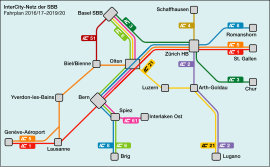
| Genève-Aéroport-Nyon-Morges-Lausanne-Fribourg/Freiburg-Bern-Zürich HB-Zürich Flughafen-Wil-Uzwil-Flawil-Gossau SG-St. Gallen |
| Zürich HB -Zug-Arth-Goldau | - | Bellinzona-Lugano | |
| -Flüelen- |
| Basel SBB- | Zürich HB | • | |
| Basel SBB - | -Sargans-Landquart-Chur | ||
| • | - Sargans - Landquart - Chur |
| Zürich HB -Schaffhausen-Singen (Hohentwiel) | -Stuttgart Hbf | |
| • |
| Genève-Aéroport -Genève-Morges- | Yverdon-les-Bains-Neuchâtel-Biel/Bienne | - | Solothurn | - | Olten | -Aarau- | Zürich HB | • | |
| Lausanne - | -Grenchen Süd- | -Oensingen- | - | - Zürich Flughafen -Winterthur- St. Gallen |
| Basel SBB - Olten - Bern -Thun-Spiez-Visp-Brig |
| Brig - Visp - Spiez - Thun - Bern - Zürich HB - Zürich Flughafen - Winterthur -Frauenfeld-Weinfelden-Amriswil-Romanshorn |
| Basel SBB - Olten -Luzern- Arth-Goldau | - | Bellinzona- Lugano | |
| - Flüelen - |
| Basel SBB -Laufen-Delémont-Moutier-Grenchen Nord- Biel/Bienne |
| Basel SBB | - | Olten - Bern - Thun - Spiez -Interlaken West-Interlaken Ost | |
| - Liestal - |
InterRegio
[edit]Lines IR26 (since 2020), IR35 (since 2021), and IR46 (since 2020) are jointly operated withSüdostbahn(SOB). Lines IR17 and IR65 are operated byBLSsince December 2020 and December 2019, respectively.[34]
| Zürich HB -Zürich Oerlikon- Flughafen - Winterthur - Wil - Uzwil - Flawil - Gossau SG - St Gallen -Rorschach-St. Margrethen-Heerbrugg-Altstätten SG-Buchs SG-Sargans -Bad Ragaz- Landquart - Chur |
| Genève-Aéroport - Genève -Nyon- Morges - Lausanne -Palézieux-Romont FR- Fribourg/Freiburg - Bern -Zofingen-Sursee- Luzern |
| Bern - Olten - Aarau -Brugg AG-Baden- Zürich HB |
| Basel SBB - Olten - Luzern - Arth-Goldau -Schwyz-Brunnen- Flüelen -Erstfeld-Göschenen-Airolo-Ambri-Piotta-Faido-Lavorgo-Bodio TI-Biasca-Castione-Arbedo-Bellinzona-Cadenazzo-Tenero-Locarno |
| Basel SBB | - | Liestal-Sissach-Gelterkinden- Olten - Zofingen - Sursee - Luzern | |
| - Muttenz - |
| Bern - Burgdorf - Herzogenbuchsee -Langenthal- Olten -Zürich Altstetten- Zürich HB |
| Basel SBB -Rheinfelden | - | Frick- Brugg AG - Baden | -Dietikon- Zürich Altstetten - | Zürich HB | - Zürich Oerlikon - Zürich Flughafen | |
| - Stein-Säckingen - | - | • |
| Basel SBB - Liestal - Sissach - Aarau - Lenzburg - Zürich HB | - Zürich Flughafen - Winterthur - Wil SG - Gossau SG - St.Gallen | |
| • |
| Luzern - Zug - Thalwil - Zürich HB |
| Luzern -Rotkreuz- Zug -Baar-Thalwil- Zürich HB - Zürich Flughafen - Winterthur - Frauenfeld - Weinfelden -Kreuzlingen-Konstanz |
| Genève-Aéroport - Genève | - Nyon - Morges - | Lausanne -Vevey-Montreux-Aigle | - | Martigny-Sion-Sierre/Siders | -Leuk- | Visp-Brig | |
| - | -Bex-St-Maurice- | - |
Regio Express
[edit]The RE1 service is operated byThurboand the RE80 service byTILO.
| RE1 | Konstanz–Kreuzlingen Hafen–Romanshorn–St. Gallen–Herisau |
| RE4 | La Chaux-de-Fonds–St-Imier–Courtelary–Sonceboz-Sombeval–Biel/Bienne |
| RE6 | Olten–Aarau–Lenzburg–Wohlen–Rotkreuz–Arth-Goldau(limited service) |
| RE6 | Le Locle–Le Crêt-du-Locle–La Chaux-de-Fonds Les Forges–La Chaux-de-Fonds–Les Hauts-Geneveys–Les Geneveys-sur-Coffrane–Chambrelien–Neuchâtel |
| RE9 | Frasne–Pontarlier–Travers–Neuchâtel |
| RE12 | Olten–Aarau–Wildegg–Brugg AG–Turgi–Baden–Wettingen |
| RE24 | Luzern–Emmenbrücke–Rothenburg Station–Sempach-Neuenkirch–Sursee–Wauwil–Nebikon–Dagmersellen–Reiden–Zofingen–Olten |
| RE33 | Annemasse–Genève-Eaux-Vives–Lancy-Pont-Rouge–Geneva–Coppet–Nyon–Gland–Rolle–Allaman–Morges–Renens VD–Lausanne–Vevey–Montreux–Villeneuve VD–Aigle–Bex–St-Maurice |
| RE37 | Aarau–Lenzburg–Zürich HB |
| RE48 | Zürich HB–Zürich Oerlikon–Bülach–Schaffhausen |
| RE56 | Biel/Bienne–Delémont–Delle–Meroux TGV |
| RE80 | Locarno–Tenero–Gordola–Riazzino–Cadenazzo–S. Antonino–Lugano–Mendrisio–Chiasso | –Como San Giovanni–Albate-Camerlata–Seregno–Monza–Milano Centrale |
| • |
Customer services
[edit]SBB offers additional services for customers.[35]SBB Digital promotes new digital services for customers. For example, SBB started a collaboration with the recruiting matchmaking service, Jacando,[36]and their own co-working space in Zürich.[37]SBB has won CRM awards in Switzerland for their SBB Digital activities.[38]
Airline codeshare
[edit]- SBBcodeshareswithAmerican Airlines,Swiss International Air Lines,andUnited Airlinesout ofZurich Airport.
See also
[edit]Notes and references
[edit]Notes
[edit]- ^Although it is the abbreviation "VFS" that is registered in thecommercial register of the canton of Bern,it is not used in federal documents and laws in Romansh.
- ^Although the abbreviation "SFR" is also registered in thecommercial register of the canton of Bern,it is never used.
References
[edit]- ^abcde"SR/RS 742.31 Bundesgesetz über die Schweizerischen Bundesbahnen (SBBG/LCFF/LFFS): Art. 2 Firma, Rechtsform und Sitz, §1"(federal law) (in German, French, and Italian). Berne, Switzerland: Federal Council: Federal Lex (fedlex). 20 March 1998.Retrieved3 April2023.
Unter der Firma «Schweizerische Bundesbahnen SBB, Chemins de fer fédéraux CFF, Ferrovie federali svizzere FFS» besteht eine spezialgesetzliche Aktiengesellschaft mit Sitz in Bern.
- ^abc"Official Federal Abbreviations"(PDF)(official). Berne, Switzerland:Federal Chancellery of Switzerland.19 September 2012.Archived(PDF)from the original on 1 April 2023.Retrieved2 April2023.
- ^abc"TERMDAT - The terminology database of the Federal Administration: SBB"(official). Berne, Switzerland: Federal Chancellery. 16 November 2016.Retrieved3 April2023.
- ^abc"Schweizerische Bundesbahnen".fedlex.data.admin.ch(official).Retrieved4 April2023.
- ^https:// swissinfo.ch/eng/workplace-switzerland/swiss-federal-railways-monika-ribar-i-really-wanted-to-get-involved-and-achieve-something-great/87495300?utm_source=multiple&utm_medium=website&utm_campaign=bundle-front1_en&utm_content=o&utm_term=wpblock_teaser-bundle
- ^abcd"Facts and Figures – Finance 2022".Berne, Switzerland: Swiss Federal Railways. 2023.Retrieved3 April2023.
- ^"Facts and Figures – Personnel".Berne, Switzerland: Swiss Federal Railways. 2023.Retrieved3 April2023.
- ^"Imprint".Swiss Federal Railways.Retrieved2 February2022.
Swiss Federal Railways SBB Passenger Services Markets Trüsselstrasse 2 3000 Berne 65 Switzerland
- ^"the 2017 European Railway Performance Index".Boston Consulting Group. 18 April 2017.
- ^"We are SBB".Bern, Switzerland: SBB CFF FFS. Archived fromthe originalon 2 April 2020.Retrieved31 January2018.
- ^"Lescha davart il persunal da la Confederaziun (LPers)"(PDF).fedlex.data.admin.ch(in Romansh). 24 March 2000.
- ^"Tschertga".Radiotelevisiun Svizra Rumantscha(in Romansh).Retrieved4 April2023.
- ^"Organizational structure | SBB".
- ^abcdefghijk"Infrastructures".SBB CFF FFS. 2018.Retrieved21 July2019.
- ^"Personnel".SBB CFF FFS.2018.Retrieved21 July2019.
- ^abc"Transportation".SBB CFF FFS.2018.Retrieved21 July2019.
- ^ab"Quality".SBB CFF FFS.2018.Retrieved21 July2019.
- ^abcdefg"Rolling Stock".SBB CFF FFS.2018.Retrieved21 July2019.
- ^SBB history page
- ^Murray Hughes (1 May 2005)."Bahn 2000 is working".Railway Gazette International.
- ^"Supervising Swiss tracks".Railway Gazette International.26 June 2010.Retrieved21 July2010.
- ^Hoffman, Andy (13 January 2019)."Swiss Rail Service Planning Electric Flying Taxis: Report".Bloomberg L.P.Retrieved20 January2019.
- ^"Remarkable clocks and watches: the Swiss railway clock".swissworld.org.Bern: Presence Switzerland, Swiss Federal Department of Foreign Affairs FDFA.Retrieved11 December2014.
- ^abcKöbi Gantenbein, ed. (2013).Die Bahnhofsuhr – Ein Mythos des Designs aus der Schweiz(in German). Zürich: Edition Hochparterre. Archived fromthe originalon 4 November 2014.Retrieved19 October2014.
- ^"Mobetime – Swiss Time Systems: References".MOSER-BAER SA.Sumiswald, Bern.Retrieved19 October2014.
- ^"Bombardier réclame des centaines de millions aux CFF"[Bombardier claims for several hundreds of millions of francs from the SBB].24 Heures(in French). 22 January 2014.Retrieved15 August2014.
- ^"SBB Approves Pre-Series Twindexx EMU".Railway Gazette International.11 June 2015.Retrieved14 July2016.
- ^"SBB Orders More ETR610 Tilting Trains".Railway Gazette International.2 February 2015.Retrieved14 July2016.
- ^"ETR610 Arrives in Switzerland".Railway Gazette International.28 June 2014.Retrieved14 July2016.
- ^"SBB's First Giruno Cars Take Shape".Railway Gazette International.8 July 2016.Retrieved14 July2016.
- ^""Es – B – B", "C – F – F", "F – F – Es"".sbbcffffs-community.sbb.ch(in French). 13 December 2018. Archived fromthe originalon 8 August 2020.Retrieved30 January2024.
- ^"SBB: Train identification".Swiss Federal Railways.2014.Retrieved15 August2014.
- ^"TGV Lyria Network".Lyria SAS.2013.Retrieved15 August2014.
- ^"Die BLS ist bereit für Bern – Olten"(in German).Retrieved17 December2023.
- ^"SBB customer service".sbb.ch.2014.Retrieved11 July2014.
- ^"SBB werden zum Nebenjob-Vermittler".20 Minuten(in German). 2014.Retrieved11 July2014.
- ^"Silicon Bahnhof - SBB Co-Working Space".Handelszeitung(in German). 2014.Retrieved11 July2014.
- ^"Gewinner Innovation".Swiss CRM Institute AG(in German). 2014.Retrieved11 July2014.
External links
[edit]- English SBB website
- We are SBBArchived2 April 2020 at theWayback Machine
- The SBB cargo websiteArchived18 September 2004 at theWayback Machine
- The CityNightLine website in German, Dutch, or EnglishArchived24 August 2004 at theWayback Machine
- Hans-Peter Bärtschi:Federal RailwaysinGerman,FrenchandItalianin the onlineHistorical Dictionary of Switzerland,27 November 2012.
- Swiss Federal Railways
- Rail transport in Switzerland
- Transport in Switzerland
- Railway companies established in 1902
- Railteam
- Government-owned companies of Switzerland
- Federal Department of Environment, Transport, Energy and Communications
- Companies owned by the federal government of Switzerland
- Swiss companies established in 1902
- Swiss brands
